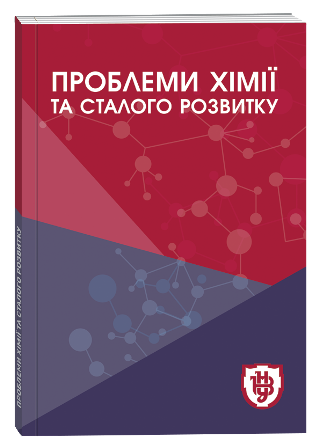POTENTIOMETRIC SENSOR FOR THE DETERMINATION OF LEVAMIZOLE
DOI:
https://doi.org/10.32782/pcsd-2023-2-1Keywords:
levamisole-selective sensor, potentiometry, determination of levamisoleAbstract
The development of applied ionometry at the stage requires both theoretical research, invested in elucidating the nature of the selectivity of electrode membranes, and the search for new methods of membrane synthesis and its modification in order to obtain more perfect structural units with a wider range. functional properties of these materials. To solve this problem, an important role is played by establishing a connection between the structural characteristics of the membranes and their influence on the electroanalytical properties. The interaction of the organic cation of levamisole (Lev+) with eosin H (ЕН-) was investigated by the method of mathematical modeling, and the energy efficiency of the formation of IA was substantiated. Using the method of mathematical modeling, the energy efficiency of the formation of the IA is substantiated. Molecular modeling of the Lev– + EH- systems and related calculations were performed using the HyperChem 8.0 package for various initial options for the arrangement of counterions relative to each other (“single point” procedure). Geometrical optimization of ions was carried out using the MM+ molecular mechanics method. A levamisole-selective sensor with a plasticized polyvinyl chloride membrane was developed. The electrode contains the ionic associate of levamisole with eosin H. To model the composition of the membrane, PVC was used as a matrix; investigated membranes plasticized with dibutyl phthalate (DBF), diethyl phthalate (DEF), dioctyl phthalate (DOF), dinonyl phthalate (DNF), dibutyl sebacinate (DBS), tricresyl phosphate (TCF). It was established that the nature of the plasticizer somewhat affects the steepness and to some extent the detection limit of the sensors. The response is linear within the range of changes in the concentration of Lev ions 1·10–5–1·10–1 mol/l with a slope of the electrode function of 53.1 ± 1.0 mV/pС. The sensor has a fast response time of 10 s and can be used for at least 8 weeks without any deviations in the long term. Sensors with a higher content of plasticizer work longer than with a lower content. The electrode can be used in the pH range of 3.0-8.0. Selectivity coefficients for levamisole against potentially interfering ions were investigated. Selectivity coefficients for levamisole against potentially interfering ions were investigated. To evaluate the developed sensors, they were tested against levamisole in model solutions and dosage forms. This sensor was used as an indicator electrode in the potentiometric determination of levamisole in the Decaris and Levamisole-pharmacevtikal preparations.
References
Машковський М.Д. Лікарські засоби. Медицина, 1986. 624 с.
Фарбер H.A. Клінічне застосування левамізолу перспективи та застереження. Терапія. архів. 1980. № I. С. 95–100.
Ковальов І. Є. Левамізол як імуностимулятор. Хім-Фарм. Журн. 1980. № 4. С. 115–121.
Adams J.G. Pharmacokinetics of levamisole. J. Rheumatol. 1978. Vol. 5. P. 137–142. [PubMed]
International Pharmacopoeia. T.2. Specifications for quality control of pharmaceuticals. Geneva: World Health Organization, 1983. 364 p.
Woestenborghs R. Determination of levamisole in plasma and animal tissues by gas chromatography with thermionic specific detection. Journal of Chromatography. 1981. Vol. 224. P. 25–32. DOI: 10.1016/s0378-4347(00)80134-6
Kouassi E., Caillé G., Léry L., Lariviere L., Vezina M. Novel assay and pharmacokinetics of levamisole and p-hydroxylevamisole in human plasma and urine. Biopharm. Drug Dispos. 1986. Vol. 7. – P. 71–89. DOI: 10.1002/bdd.2510070110
Alvinerie M., Galtier P., Escoula G. Ion-pair high performance liquid chromatographic assay of levamisole in biological fluids. J. Chromatogr. 1981. Vol. 223. P. 445–448. DOI: 10.1016/s0378-4347(00)80120-6
Vandamme Th.F., Demoustier M., Rollmann B. Quantitation of levamisole in plasma using high performance liquid chromatography. Europian journal of drug metabolism and pharmacokinetics. 1995. Vol. 20. № 2. P. 145–149. DOI.org/10.1007/BF03226369
De Baere S., Cherlet M., Croubles S. Liquid Chromatographic determination of levamisole in animal plasma: ultraviolet versus tandem mass specrometric detection. Anal. Chim. Acta. 2003. Vol. 483. P. 215–224. DOI: 10.1016/S0003-2670(02)01377-6
Holbrook A., Scales B. Polarographic determination of tetramisole hydrochloride in extracts of animal tissue. Anal. Biochem. 1967. Vol. 18. P. 46–53. doi.org/10.1016/0003-2697(67)90054-1
Rousseau F., Haguenoer J. M., Lesieur D., Gamot A. P. Gas-chromatographic determination of levamisole in human plasma-normalization and reliability of the method. European Journal of Drug Metabolism and Pharmacokinetics. 1981. Vol. 6. P. 281–288. DOI: 10.1007/bf03189527
Marriner S., Galbraith E.A., Bogan J.A. Determination of the anthelmintic levamisole in plasma and gastrointestinal fluids by high-performance liquid chromatography. Analyst. 1980. Vol. 105. № 1255. P. 993–996. doi.org/10.1039/AN9800500993
Крамаренко В.Ф. Токсикологічна хімія. Київ: Головне видавництво видавничого об'єднання «Вища школа», 1989. 423с.
Камман К. Робота з іоноселективними електродами. Москва: Світ, 1972. 283 c.







